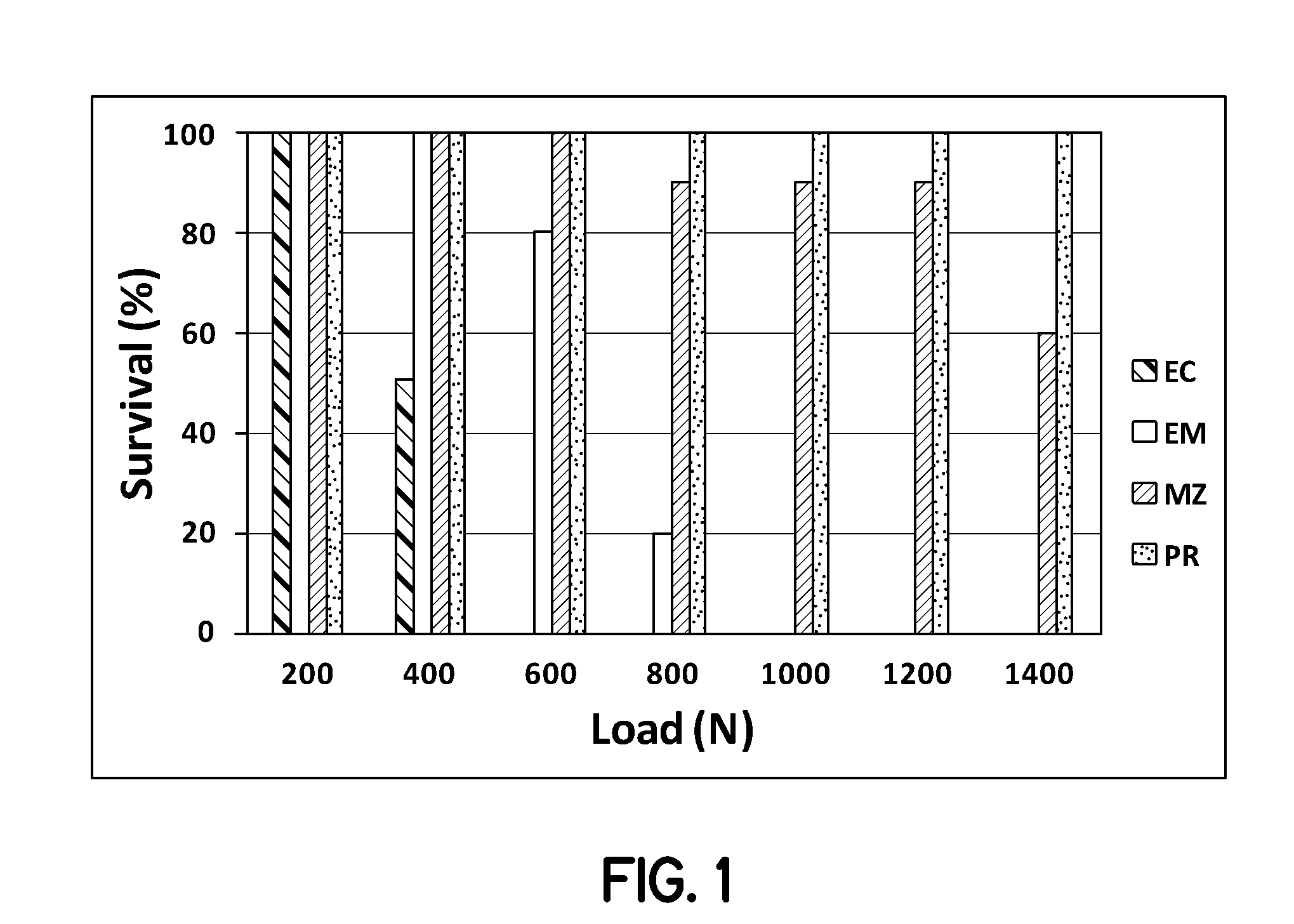Dental compositions containing short-cut fibers
- Summary
- Abstract
- Description
- Claims
- Application Information
AI Technical Summary
Benefits of technology
Problems solved by technology
Method used
Image
Examples
example 1
[0049]An exemplary formulation using Belleglass™ Translucent Dentin Resin with 10 PHR polymeric short-cut fiber filler includes about 24.3 wt % Resin, 2.4 wt % fiber filler and 73.3 wt % particulate filler, wherein the wt % is based on the total weight of the composite. To determine the effect, if any, of varying the length and amount of polymeric short-cut fiber filler, various samples were prepared. Various lengths of polyester short-cut fiber (Engineered Fibers Inc.) were cold gas plasma treated (Fourth State Inc.) to produce hydroxyl and carboxyl functionality, treated with methacrylic anhydride (5%) in tetrahydrofuran, filtered and vacuum dried at 80° C. for 6 hrs. The fibers were mixed into Belleglass™ Translucent Dentin Resin in concentrations from 0 to 20 PHR (Parts Per Hundred Resin) and compounded into pastes with Belleglass™ Translucent Dentin Filler, which includes the particulate filler described in commonly-owned U.S. Pat. No. 6,121,344 by Angeletakis et al. Specifical...
example 2
[0051]Another formulation of the indirect composite resin, Belleglass™ Translucent Dentin, was prepared. Various amounts and lengths of polyethylene short-cut fiber (Spectra® 1000, Honeywell Corp.) were cold gas plasma treated under the same conditions used in Example 1. The surface modified fibers were subsequently treated with γ-methacryloxypropyl trimethoxy silane, A-174 (OSI Specialties, Inc.) as a 10% methanolic solution, filtered, and vacuum dried at 80° C. for 6 hrs. The dried fibers were then mixed into Belleglass™ Translucent Dentin Resin, in lengths of 1 mm to 5 mm and in amounts of 0 to 25 PHR, and compounded into pastes with Belleglass™ Translucent Dentin Filler. The formulations were cured per the manufacturer's instructions and tested for fracture toughness, flexural strength and modulus according to the Single Edge Notched Beam Method (SENB) and ISO 4049, respectively. The results are shown in Table 4, with standard deviation (s.d.) in parentheses.
TABLE 4Belleglass ™ ...
example 3
[0053]The formulation in Example 2 was applied to Computer Aided Design / Computer Aided Manufacturing (CAD / CAM) processing. Several formulations containing 5 mm fibers were evaluated in processed blocks. The formulations were compression molded into blocks at 100° C. while under 5,000 psi of pressure for 1 hour. The cured specimens were machined using a diamond saw for testing. The data is summarized in Table 5, with standard deviation (s.d.) in parentheses.
TABLE 5Belleglass ™ Translucent Dentin Resin and fillerwith Polyethylene Short-Cut Fiber, CAD / CAM ProcessedFiberFiberFlex.Flex.LengthamountKIcStrengthModulus(mm)(PHR)MPa · m1 / 2 (s.d.)MPa (s.d.)GPa (s.d.)n / a01.04 (0.04)142 (10) 13.1 (0.7) 5101.85 (0.4) 94 (15)7.1 (0.9)152.29 (0.81) 84 (8.0)7.0 (0.7)
[0054]The formulation in Table 5 without short-cut fiber filler was used as a control sample. In general, the fracture toughness was again improved with increasing fiber filler content, but other physical properties did not show an impro...
PUM
| Property | Measurement | Unit |
|---|---|---|
| Temperature | aaaaa | aaaaa |
| Length | aaaaa | aaaaa |
| Length | aaaaa | aaaaa |
Abstract
Description
Claims
Application Information
 Login to View More
Login to View More - R&D
- Intellectual Property
- Life Sciences
- Materials
- Tech Scout
- Unparalleled Data Quality
- Higher Quality Content
- 60% Fewer Hallucinations
Browse by: Latest US Patents, China's latest patents, Technical Efficacy Thesaurus, Application Domain, Technology Topic, Popular Technical Reports.
© 2025 PatSnap. All rights reserved.Legal|Privacy policy|Modern Slavery Act Transparency Statement|Sitemap|About US| Contact US: help@patsnap.com

